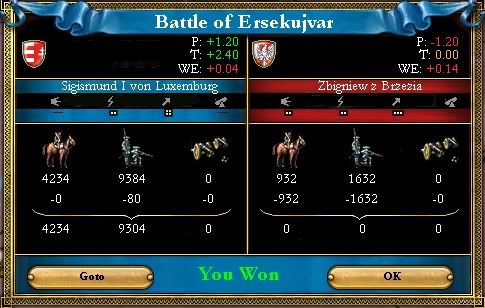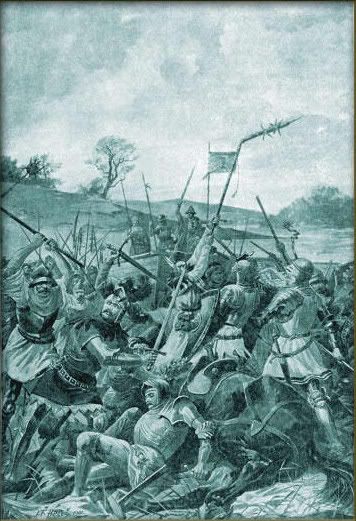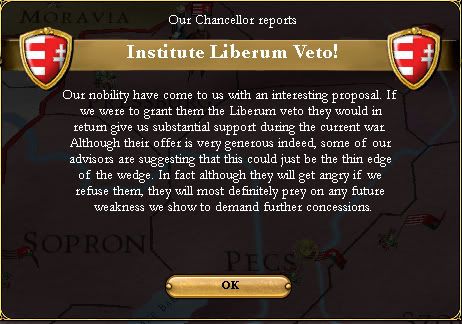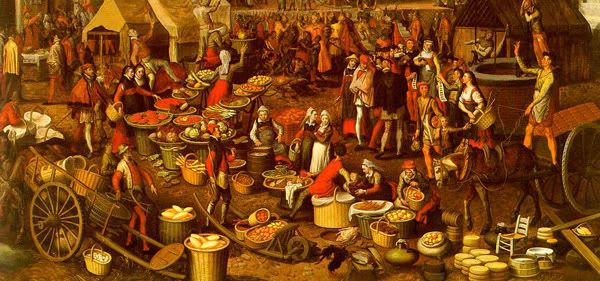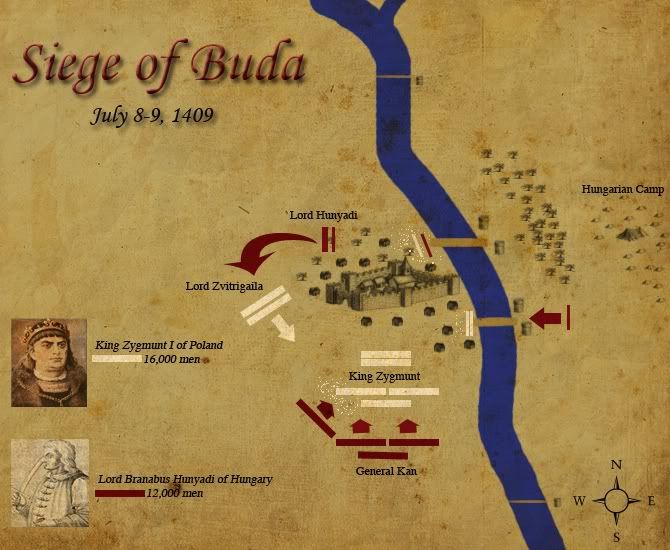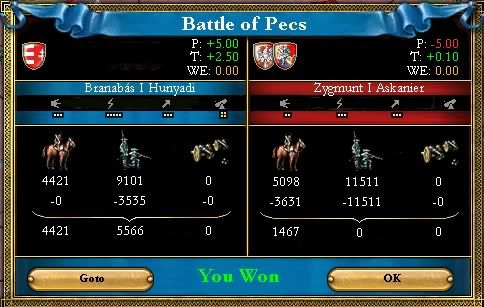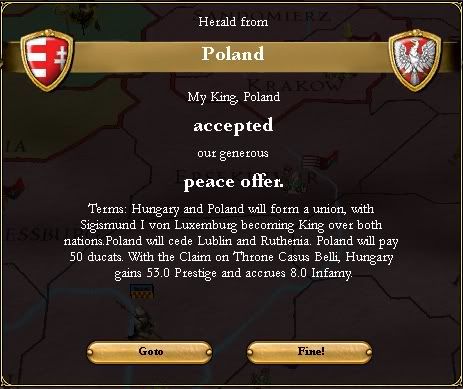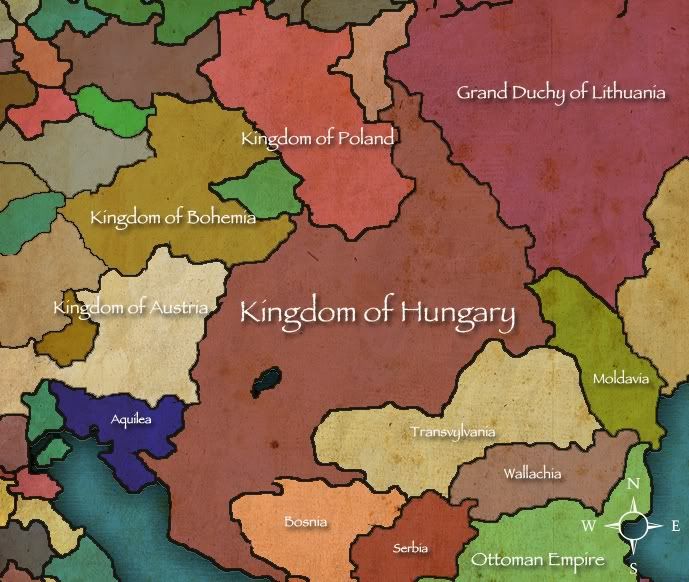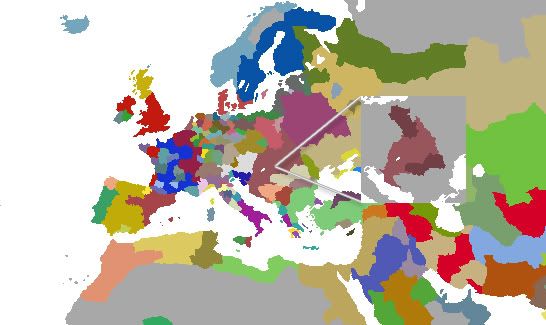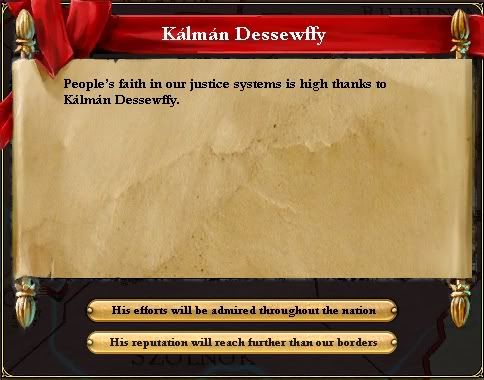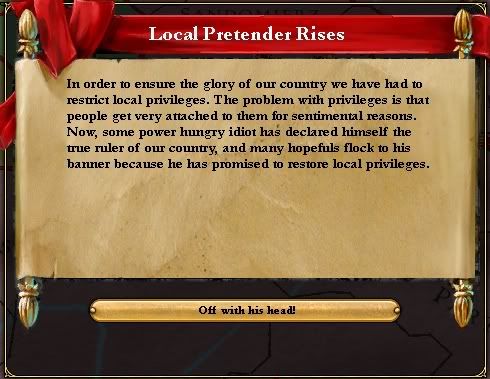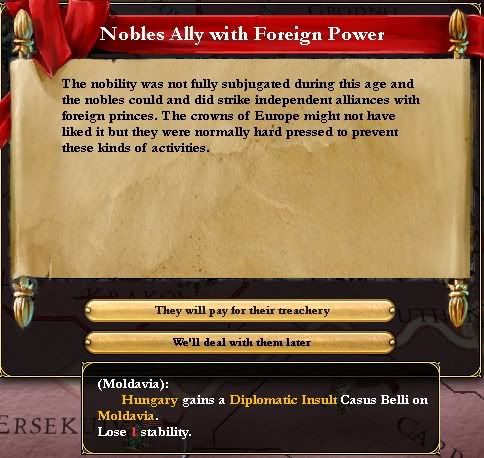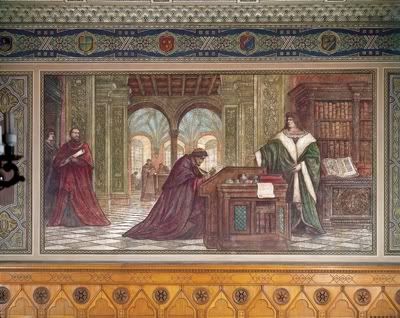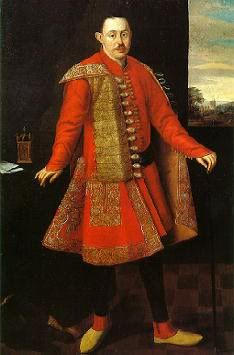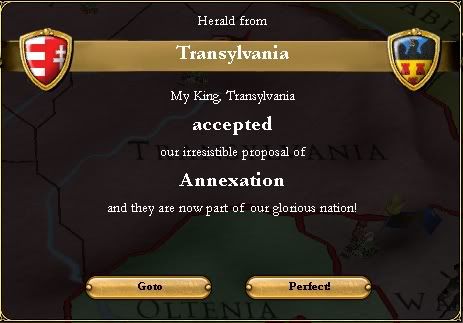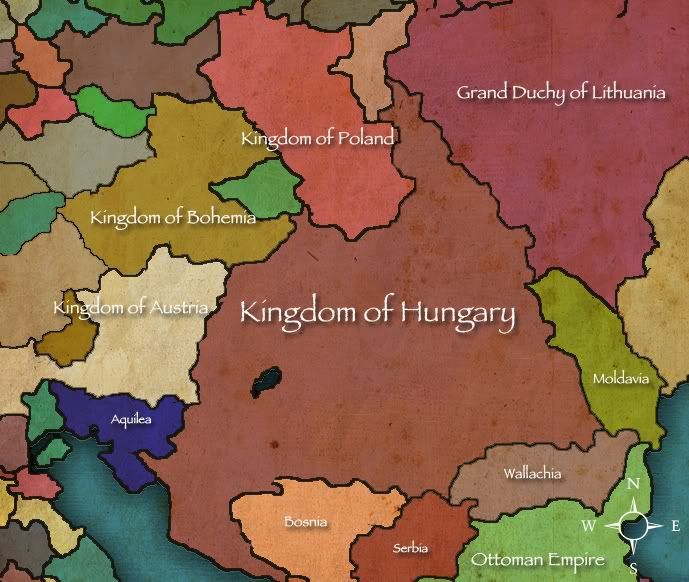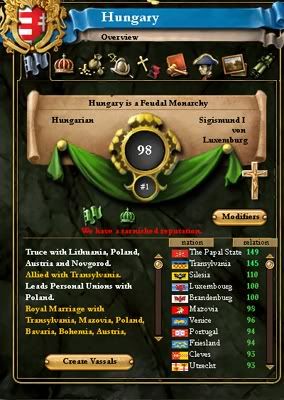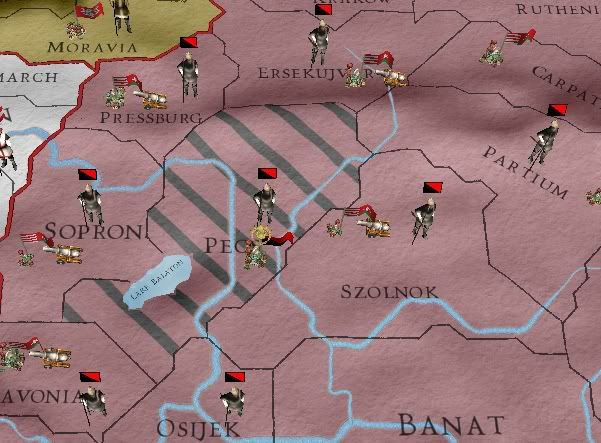Chapter IV – Poland’s Swan Song
By mid-year of 1407, the Kingdom of Hungary was standing strong against the alliance brought against them. Novgorod had bowed out of the war by signing a white peace in April of 1406. Poland’s armies were scattered throughout its own land with only one army led by King Zygmunt posing a viable threat against Hungary. Austria, for the time being was still occupied with France, allowing Lord Hunyadi to concentrate in the east. With the threat of Novgorod having been vanished, King Sigismund wanted to pick up on his earlier goal of chasing Zygmunt of Poland and capturing the king.
Yet, as the war has shown time after time, Sigismund’s plans were dashed when he received word that a large Lithuanian army had invaded Hungary. Sigismund, including Hunyadi and others were all shocked by Lithuanian’s involvement in the war. Though Lithuania always had good relations with the Poles, it was never thought that Lithuania would risk open war with Hungary.
(1) Sigismund’s gamble that Lithuania would stay neutral had failed. The Duchy of Lithuania was helping their brother in arms in a considerable way. A small army of 2,000 Lithuanians scouted eastern Hungary reaching Partium before being confronted by a detached army of Sigismund’s right guard. A battle took place on April 21, 1407. The battle was an overwhelming victory for the Huns, for the Lithuanians were lightly armored to allow them to cover a large distance of land in a minimal amount of time. The Huns destroyed the scouting army with many Lithuanians perishing in the battle while others were taken prisoner. Only a handful of Lithuanians were able to escape and flee back east toward the main part of the army.
Sigismund made the mistake in thinking the scouting army was the threat the report described. He moved his army north to invade Poland once again. With Sigismund’s tactical error, the report’s actual threat, a large Lithuanian army numbering 12,000 men was free to march on Pecs to besiege the Hungarian capitol, Buda.
As Sigismund’s army marched to Poland, they met resistance in Ersekujvar. Nearly 3,000 Polish solders were ransacking and pillaging Hungarian villages. The Poles, led by a daring and greedy man, General Brzezia, had no respect for the Huns. The army stole, raped and killed before burning everything else. Rumors that an army of pillagers was in the region had caught the ear of Sigismund months before, but the King believed the rumors to be false; a ruse the Polish concocted to divert and distract his army. The devastation the King saw on the way through Ersekujvar angered him. The Huns were devastated over the destruction the Poles had created. Lowly farmers, herdsmen, and other peaceful folk had received the brunt of war. Many sons in the Hungarian army saw their homes completely burned and some were even unfortunate to learn of a family member’s death occurred during the Polish rampage. By the time, Sigismund encountered the army of General Brzezia, it had killed over 400 civilians, ransacked three whole villages and burned fields worth over $800,000 ducats. Emotion running high and adrenaline taking its effect, the army of General Brzezia was quickly routed and picked apart by the vengeful Huns. In all, the Huns suffered only 80 casualties in the battle whereas the Poles were completely massacred to the last man. King Sigismund did nothing to restrain his men.
(2)
Surviving accounts were scarce for the battle, yet one bone chilling account exist that vividly describes the brutality and blood cries witnessed in the battle and its aftermath. As a Magyar nobleman, Emeric Khuen de Belasi wrote,
“The impending battle with the Poles had gripped the men’s fervor to revenge what had been lost the past couple months. The wretched Poles were taken by surprise in our devastating and quick ambush on their camp. Most of the Poles were still sleeping as our men slowly and enjoyably took vengeance. The men who wrestled awake had barely enough time to grab their swords. The Poles were screaming to their comrades for help, but no help would arrive. I saw one Polish soldier surrendering to a couple of our men. The surrendered Pole was on his knees begging for his life. One of the Huns without hesitation went over to the Pole and pierced the helpless man through the chest. The Hun kicked the soldier off his sword as blood poured out of the wound and onto the damp grass beneath them. The carnage was awful. Countless Poles were savagely hacked to death in their sleep, with no warning or pause from our army. There was nothing left that would remotely remind you of a Polish army. Only the dismembered and bloody remains of unfortunate bastards paying the price for their sins. We have done our duty this day. We have sent those poor souls to meet the Maker and He will judge them accordingly. “
While Sigismund’s army was slaughtering Poles in the north, Lord Hunyadi’s army was quickly marching back to Pecs in hope of intercepting the Lithuanians before they reached Buda. The same spies that had warned Sigismund of the Lithuanian threat immediately traveled to Hunyadi hoping he would listen. Initially enraged by Sigismund’s complete disregard of the homeland once again, Hunyadi immediately sent out request for mercenaries to supplement his ranks. In the early part of 1407, Hunyadi had allowed furloughs for many of the soldiers to return to their homes. Even though the men had earned it, Hunyadi was no facing an army that outnumbered his 3:1. Any hope of defeating the army would lie upon hired mercenaries.
(3)
By the beginning of August 1407, Lord Hunyadi had traversed Hungary and arrived outside of Buda. Awaiting him were the mercenaries he had hired earlier in the year. With the 6,000 mercenaries and the 1,500 Huns garrisoned in Buda, Hunyadi now had an army he could use to defend the capitol. Hunyadi inspected the mercenaries and was relatively displeased with their character and appearance. Most of the mercenaries were Italians, though some were German and French. Though displeased, the general was fortunate to have them and the mercenaries would prove themselves quite useful in the next coming months. The Lithuanian army numbering well over 14,000 men reached Pecs in late August. Defenses around the city were still being built and Hunyadi knew the city would only be able to hold a siege for a few months. The garrison commander failed to store food and supplies for a lengthy siege. A pitch battle would be the only option, which could end disastrously for the Huns. The ensuing battle on August 23 was not as momentous as the Lithuanians may have wanted, and it was not the disaster Hunyadi dreaded. A failed reinforcement maneuver by the Lithuanian army allowed the Huns to reinforce its own failing right flank, which would ultimately save the day. The battle would last for only two hours and casualties were relatively light for both sides. It is believed that if the Lithuanians were able to press the right flank of the Hungarian army, the army would have broken. Yet, one small mistake by a commander echoes a much larger fatal outcome. With Buda saved, the Lithuanians withdrew from Pecs. Hunyadi not wanting them to regroup chased them into Pressburg. A larger battle was fought in Pressburg on December 16. Yet, again a decisive victory could not be had by either side as the battle ended as a draw. However, casualties were considerably higher in the Battle of Pressburg with over 7,000 men falling on both sides. The Battle of Pressburg in early October would be the final engagement of 1407.
The Battle of Pressburg failed to achieve the victory King Sigismund yearned.
Hunyadi’s army established winter quarters in the province of Ersekujvar. With his army camped in the winter, Lord Branabus Hunyadi and his aid-de-camp would travel to Krakow in December of 1407 for a summons of nobles called by King Sigismund.
(4) Many Hungarian nobles answered the summons and traveled to Krakow to meet with their king. Sigismund desperately needed his nobility to help in the current war. The kingdom’s treasury was empty and Sigismund personally had used some of his family’s wealth to fund a few months of campaigning in Poland. However, money was running dry and without the help of his nobility, he would not be able to afford to keep the mercenaries in the army. Sigismund’s army including Hunyadi’s army were weak and would not be able to sustain with another extended campaign. After the winter, Sigismund knew the war would be lost in only a few months. Their exhausted and depleted armies would lose against the fresh Lithuanians, the experienced Austrians and the smaller but morale driven Poles. Through the current war, the Hungarian nobility had only supported their king with hollow words. The nobility refused to send their armies to campaign, though some nobles did help Hunyadi in defense of Carpathia and Pecs. The nobility knew Sigismund needed their support.
Not many records exist that explain exactly what occurred in Krakow in the weeks of December, but one thing is for certain, the outcome gave Sigismund the support he so desperately needed while the nobility gained an upper hand against the king and the Hungarian court. King Sigismund agreed to the principles of liberum veto, which states that unanimity among the court is needed for any decision to be enacted in Hungary. It was a very powerful notion and victory for the Hungarian nobility. Simultaneously, it was a thorough defeat for Sigismund’s overall claim to power on the Hungarian throne.
(5) No longer would the king be able to force his nobility to support his actions. Politics, it seems would have to be the mainstay in his ability to control the nobles and his throne. Though it was a humiliating concession on behalf of the king, it did give him the support to continue the war. The nobility promised 10,000 men to the cause of defeating the alliance of Poland, Lithuania and Austria. This decision made in December of 1407 would be a defining moment for the future birth of the Hungarian empire.
Liberum Veto gave Sigismund the support he needed but for a grave price
In 1408, the beginning of spring introduced many battles in Poland and Hungary as the War for the Polish Throne continued. The Hungarian nobles promise of men stayed true and the reinforcement of the Hungarian armies allowed Sigismund and Hunyadi to win average victories through the year. These victories include the Battle of Krakow in February, the Battle of Siradz in April and the Battle of Lublin in September. Yet, the Huns did not only see a string of victories for their armies. The Hungarians also lost a couple key battles during 1408 consisting of the Battle of Lublin in May and the Battle of Ruthenia in September. These two defeats cost over 3,800 Hungarian lives. In the end of 1408, the Huns had failed to win a decisive victory against the Poles.
Sigismund was getting frustrated with the war. It was dragging into its fifth year, and the Kingdom of Hungary was experiencing the ravages of war. The economy was nearly stagnant; most of the country’s merchants had gone bankrupt during the years. Yet worse, the Kingdom of Hungary was in massive debt, and soon some of the loans would be called in. Most of the loaning houses were getting impatient with Hungary; it had done nothing but squandered its money on a fruitless war. Hungary had seen victory, yes, but the status quo still existed. Thousands of Huns had died through the five years of war with very little gained. More and more Magyars were wavering under the growing famine of the country, the deaths of their sons, and the crippling taxes forced upon them by their king. Some nobles including Branabus Hunyadi did all they could in helping the poor peasantry. Even with limited help, the peasantry was failing fast. If Sigismund did not gain a decisive victory soon, the Kingdom of Hungary would simply fall apart.
Lord Hunyadi helping the Hungarian citizenry with food donations from his family's stores
During the early part of 1409, the war continued to be a static entity with no clear winner or loser. Sigismund’s campaign in Poland was gaining territory, yet he could not engage the enemy in a single battle. The king captured province after province but no army clashed with him. It seemed Poland was trying to win a war of attrition, a war that could finally beat the Huns. However, Lithuania had other intentions.
In June of 1409, an army of consisting of Poles and Lithuanians crossed into Hungary to march on Pecs. The Polish King Zygmunt I was convinced by the Lithuanians to agree to one large attack on the Magyar capitol. With Sigismund occupied in Poland, Buda was left with few defenses. They knew Lord Hunyadi with an army of 13,000 men was in Hungary, but they believed his position was closer to the east on the border of Lithuania. Their army marched unopposed straight to Pecs where they began to siege Buda. The defenders of Buda were much better prepared for a siege than in previous years mainly due to the instruction of Hunyadi. A messenger was secretly sent from the besieged city to warn Hunyadi whose army was in Partium. After receiving word of the siege, Hunyadi’s army made excellent timing and was in Pecs by early July. What he saw before him was a Polish-Lithuanian grand army numbering well over 16,000 men. They were heavily encamped, well supplied and in good morale. The Hun’s position was precarious at best. They were outnumbered, but Hunyadi had no choice but attempt to lift the siege.
Branabus Hunyadi's battle plan in the Siege of Buda, 1409
What would later be known as the Siege of Buda began on July 8, 1409 with the main part of the Hungarian army led by General Khan crossing the Danube River. King Zygmunt of Poland rearranged his forces to meet the Huns head on. He knew he outnumbered the Hungarians and due to this was fairly confident in his capability to win. The Lithuanians led by Lord Zvitrigaila were positioned in the north to siege the capitol of Buda from another focal point. With the Hun’s crossing, Lord Zvitrigaila would move the bulk of his army to the south to reinforce Zygmunt’s army. King Zygmunt’s left small guard positions at the bridges believing that the entire Hungarian force had crossed from the south.
(6) This error in judgment allowed Lord Hunyadi with a detachment of 4,000 men to sneak through the Buda forest and surprise the small guard in the north of the city. The Polish soldiers, caught completely unaware were quickly killed or captured. This allowed Hunyadi to wheel around the capitol and surprise Zygmunt’s army from behind.
Scouts informed Hunyadi that Zvitrigaila’s main force was slowly making its way to the front, probably due to it believing victory was a forgone conclusion. Wanting to catch the Lithuanians before reaching the front, Hunyadi rushed his men around Buda castle. The Huns covered ground with amazing speed and found the main force of the Lithuanians only 500 yards away. By this time, Zvitrigaila noticed Hunyadi and began to turn his army around. Before the Lithuanians were in position, a large Hungarian cavalry charge of 3,500 men slammed into the center of the Lithuanians. The Lithuanians numbered well over 6,000 men yet surprising the Lithuanians along with the charge broke their center. Zvitrigaila tried to rally his soldiers as countless men fell under the sword. The rally was beginning to work until a Hun cavalryman struck Zvitrigaila. The lord fell from his horse, mortally wounded. Under the bloody frenzy, horses would trample Lord Zvitrigaila’s body. It was not known what killed him first, the sword or the horse. With the death of Zvitrigaila, the Lithuanians would lose much of their fight and flee. Hunyadi’s cavalry briefly chased the Lithuanians, slashing and hacking retreating soldiers.
While Hunyadi was fighting the Lithuanians, General Khan was commanding the main part of the Hungarian army against King Zygmunt. Trusting that Hunyadi would take care of Zygmunt’s reinforcements, he ordered his left flank to wheel around and attack the right flank of Zgymunt’s army. General Khan did not want to waste any time as he simultaneously ordered a frontal assault as well. The maneuvers by General Khan took Zgymunt by surprise as he anticipated that the Huns would be more cautious. Noticing the Huns barely had any cavalry in formation, he ordered his cavalry to charge the flanking Huns and intercept them before they reached his infantry. This would signal the end for Zygmunt for it effectively separated him from the rest of his army. Though tactically intelligent to issue the charge, Zygmunt had little clue that Hunyadi was about to attack his army from the rear. The Polish King and his cavalry charged into the prepared Hungarian lines. The Poles had the clear advantage as many Huns were falling. However, before the Huns wavered, Hunyadi with his own cavalry attacked Zgymunt’s rear. The Polish cavalry being squeezed by two Hungarian armies quickly broke. In the confusion, Zygmunt was struck in the throat and instantly killed. The demise of the Polish King was not known for some time by the rest of the army. The Polish cavalry were completely decimated, yet the main part of the army continued to fight Khan’s assault. Slowly, the Poles soon saw the surviving cavalry was running off the field, not toward the main body of the army. Believing that their King had given up and was retreating disheartened the Poles and they soon fled.
The Siege of Buda was a brilliant and overwhelming victory for Hunyadi and Hungary
The Siege of Buda was an overwhelming victory for the Huns. The combined armies of Lithuania and Poland were completely crushed by Hunyadi. His brilliance once again had protected Hungary, but this time he also had done what his own king, Sigismund could not. He had killed King Zygmunt. The Polish throne was now vacant. Sigismund received the victory he needed to sway the war into Hungarian favor. Soon after the news of the sound defeat reached the Lithuanian King, he signed a separate peace with Hungary in September of 1409. The Austrians, never being a factor in the war signed its own separate peace in October of 1409 after seeing Lithuania bow out of the war. With no allies to help and no king on the throne, Poland was helpless. King Sigismund would sign a peace with Polish nobles in Krakow on December 1, 1409. The treaty announced that King Sigismund of Hungary would rule Poland under a union of the thrones. Poland would also cede Lublin and Ruthenia to the Huns. The rest of Poland would continue to be ruled by its own nobility, who rightfully agreed of Sigismund’s claim to the Polish throne.
Peace treaty between Poland and Hungary in 1409
The Kingdom of Hungary at the end of the War for the Polish Throne in 1409
The war was over. Yet as Sigismund rode through the streets of Buda like a victor, he could not help but notice that the bulk of the praise from the inhabitants was not directed at him, but to the man beside him, Lord Branabus Hunyadi.
The Kingdom of Hungary and its domains with the rest of the world in the beginning of 1410
----------------------------------
(1) - It was later known that the Duchy of Lithuania risked open war with Hungary only due to the invasion of Novgorod by Muscowy. With the Rus' attention away from their borders, Lithuania was allowed to aid Poland.
(2) - It has been debated by historians if King Sigismund actually allowed his men to massacre the Poles or if he was just incapable in controlling his own army's bloody vengeance.
(3) - With the last bit of money in the treasury, 6 divisions of mercenaries were hired to supplement the shrinking Hungarian army.
(4) - It was noted by Branabus Hunyadi that he found it folly that the king would issue a summons in Krakow, enemy territory. Though the city had fallen a year past, a summons of all nobles posed a very delicate security problem. However, King Sigismund wanted to show the nobles as well as the rest of Europe a show of strength and power for himself and Hungary. Unfortunately, all that Europe saw of it was a desperate but ultimately failed attempt by Sigismund to be accepted as a ruler of a powerful kingdom in Eastern Europe.
(5) - The announcement of the Liberum Veto in 1407 came as a surprise for most of Europe. It was the first time in European history that a monarchy would give such power to the nobility. Though later it would be seen as innovative and the first step to a bill of rights for a country's general population, it still must be kept in mind that Sigismund was forced to accept such terms. Without it, he would never have gained the nobility's support and eventually he would have lost the war and the Hungarian throne in the process.
(6) - This was the single most important decision made prior to the battle. Earlier in the week, Zygmunt received initial spy reports that Hungarian scouts were seen in Buda Forest. The King of Poland perceived it to be only reconnaissance for enemy positions by the Huns, nothing more. It would later be discovered that the Polish King heard rumors that Hunyadi would divide his force to attack Buda, but again Zygmunt dismissed it as only a rumor.


